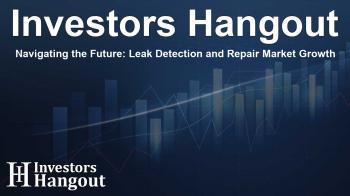Navigating the Future: Leak Detection and Repair Market Growth

Global Leak Detection and Repair Market Overview
The Leak Detection and Repair (LDAR) market is making waves, with projections estimating a significant rise in value. Currently valued at approximately USD 21.34 billion, it is anticipated to reach USD 33.25 billion by 2034, showcasing a compound annual growth rate (CAGR) of 4.51%. This growth is largely fueled by a combination of stringent environmental regulations and the increasing demand for sustainable practices among industries.
Understanding the Drivers of Market Expansion
One key driver propelling the market forward is the escalating focus on environmental sustainability. Companies across various sectors, particularly oil and gas, chemicals, and manufacturing, are under growing pressure to monitor and minimize emissions effectively. As awareness regarding greenhouse gases intensifies, regulatory bodies worldwide are imposing stricter compliance mandates. This shift towards sustainability not only aligns with corporate social responsibility but also helps companies mitigate operational risks.
Technological Innovations in LDAR
Advancements in technology greatly contribute to the market's growth. Next-generation leak detection systems now incorporate artificial intelligence (AI) and Internet of Things (IoT) capabilities, enabling efficient and accurate monitoring of pipelines and industrial installations. AI-enhanced robots and mobile sensors, such as drones, are revolutionizing the way leak detection is conducted, making inspections safer and more precise. This technological evolution is crucial in reducing methane and volatile organic compound (VOC) emissions, ensuring compliance with updated regulations.
The Role of Robotics and Automation
Robotics and automation are expected to significantly impact the future of the LDAR market. Innovations like unmanned aerial vehicles (UAVs) and AI-driven robots are enhancing leak detection methods, leading to quicker response times and improved accuracy. For example, devices like Solinas Integrity’s EndoBot utilize a mix of sensors and AI to identify leaks without extensive excavation, thus minimizing operational downtime. Such innovations pave the way for safer work environments and also support companies in adhering to environmental regulations.
Current Trends and Future Outlook
As the LDAR market evolves, several key trends are emerging. There is a notable increase in managed LDAR services as companies seek cost-effective solutions for comprehensive monitoring. Predictive maintenance is also becoming integral, allowing firms to address potential issues proactively rather than reactively. The rise of mobile, drone-mounted sensors offers businesses precise measurements and real-time data, enhancing operational efficiency across the board.
Impact of Regulatory Changes
Stringent environmental regulations play a pivotal role in shaping the LDAR landscape. Agencies worldwide, including those in North America, Europe, and Asia, are setting rigorous standards to curb VOC and greenhouse gas emissions. Non-compliance poses risks such as hefty fines and reputational damage, driving companies to invest in advanced LDAR technologies. This systemic inclination toward robust emission management systems not only aligns with legal frameworks but strengthens brand integrity.
Industry Insights and Key Players
Numerous organizations are leading the charge in the LDAR market. These include tech-driven companies specializing in innovative leak detection solutions. Notably, the collaboration between industrial partners and technology firms is enhancing the development of next-generation LDAR tools, ensuring that companies are equipped to meet both current and future challenges.
Emerging Markets and Opportunities
Emerging markets, particularly in Asia Pacific and Latin America, present lucrative opportunities for LDAR solutions. Rapid industrialization, driven by increased oil and gas production, necessitates effective leak detection frameworks. Countries such as India and Brazil are witnessing heightened demand for LDAR as industries implement stringent compliance measures to meet governmental standards. Additionally, investments in environmental programs can accelerate the adoption of advanced leak detection technologies in these regions.
Frequently Asked Questions
What is the projected market size for the Leak Detection and Repair market?
The market is projected to reach USD 33.25 billion by 2034, growing at a CAGR of 4.51%.
What are the main drivers of growth in this market?
Key drivers include increasing regulatory scrutiny, the need for sustainable practices, and advancements in monitoring technologies.
Which sectors are leading in LDAR technology adoption?
Primary adoption is seen in the oil and gas, chemicals, and manufacturing sectors due to stringent emission regulations.
What role do new technologies play in the LDAR market?
Technological innovations such as AI, IoT, and robotics improve operational efficiency and accuracy in leak detection.
How is the global market structured regionally?
North America currently leads the market, followed by Europe and the rapidly growing Asia Pacific region, with increasing investments in sustainability.
About The Author
Contact Dominic Sanders privately here. Or send an email with ATTN: Dominic Sanders as the subject to contact@investorshangout.com.
About Investors Hangout
Investors Hangout is a leading online stock forum for financial discussion and learning, offering a wide range of free tools and resources. It draws in traders of all levels, who exchange market knowledge, investigate trading tactics, and keep an eye on industry developments in real time. Featuring financial articles, stock message boards, quotes, charts, company profiles, and live news updates. Through cooperative learning and a wealth of informational resources, it helps users from novices creating their first portfolios to experts honing their techniques. Join Investors Hangout today: https://investorshangout.com/
The content of this article is based on factual, publicly available information and does not represent legal, financial, or investment advice. Investors Hangout does not offer financial advice, and the author is not a licensed financial advisor. Consult a qualified advisor before making any financial or investment decisions based on this article. This article should not be considered advice to purchase, sell, or hold any securities or other investments. If any of the material provided here is inaccurate, please contact us for corrections.

